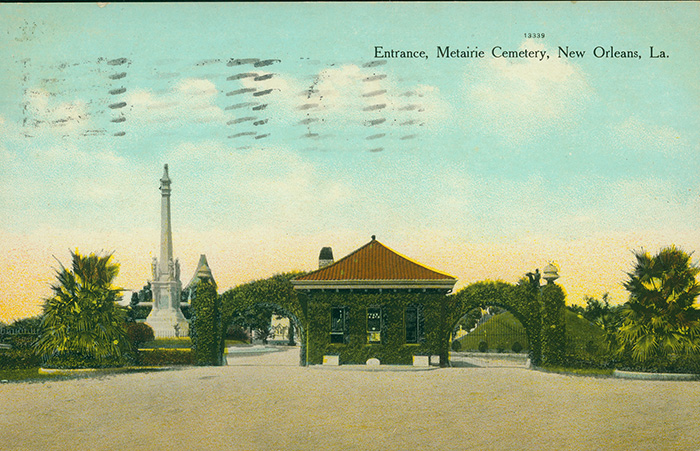Metairie Cemetery
Tombs at Metairie Cemetery are more spaciously laid out than in other New Orleans cemeteries and constitute some of the most spectacular and grandiose funerary architecture in the United States.

Courtesy of Louisiana State University Libraries, Special Collections
Metairie Cemetery. Unidentified
Metairie Cemetery was built on the original site of the Metairie Race Course, a popular and profitable racetrack in antebellum New Orleans, but one which could not survive the economic ravages of the Civil War and Reconstruction. After it shut down, the Metairie Cemetery Association purchased the site in 1872 and converted it into a sixty-five-acre landscaped burial ground. The elliptical track formed the basis of Metairie Cemetery’s design, and three smaller ellipses were laid out within it to serve as paths. Cross avenues and diagonals creating circles and triangles, live oak trees festooned with Spanish moss, and, originally, a series of lagoons created a picturesque garden of the dead in the manner of the influential Père Lachaise Cemetery in Paris.
Tombs at Metairie are more spaciously laid out than in other New Orleans cemeteries and constitute some of the most spectacular and grandiose funerary architecture in the United States. They include Greek temples, Gothic extravaganzas, Islamic pavilions, a Celtic cross, and tombs embellished with stained glass windows, broken columns, and allegorical figures. The earlytwentieth-century tomb of Lucien Brunswig, designed by the Weiblen Marble Company, features a pyramid, sphinx, and female figure gesturing toward the bronze door. Local architects designed some of the tombs, notably Theodore Brune’s flamboyant and mostly Romanesque Revival tomb for merchant Salvatore Pizzati; Favrot and Livaudais’s somber Egyptian-styled temple for lumber baron Frank B. Williams; and Burton and Bendernagel’s extraordinary Renaissance-inspired marble monument for stock-speculator Eugene Lacosst.
As the final resting place of many of New Orleans’ most influential citizens and the site of such a broad array of magnificent memorial statuary, Metairie Cemetery was added to the National Register of Historic Places in 1991. Among the notable individuals buried there are William C. C. Claiborne and eight other Louisiana governors; seven New Orleans mayors; three Confederate generals including P. G. T. Beauregard; musicians Louis Prima and Al Hirt; authors Grace King and Eve Curie Labouisse, whose biography of her famous mother, Madame Curie, won the National Book Award in 1937; World War II boat builder Andrew Jackson Higgins; and Baseball Hall of Fame member Mel Ott.
Adapted from Karen Kingsley’s Buildings of Louisiana, part of the Buildings of the United States series commissioned by the Society of Architectural Historians (www.sah.org) and published by Oxford University Press.
